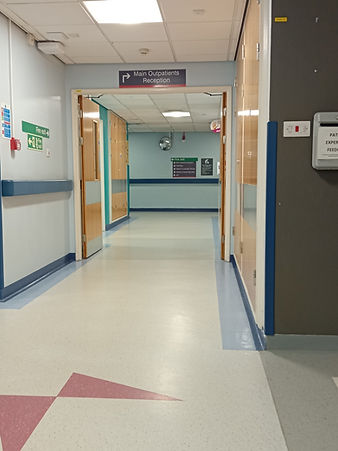Chapter 3
A Diagnosis

Neurology
April 2024. My neurology appointment.
These were the people I hoped could tell me whether this pain was permanent or temporary. By then, my mobility had deteriorated so much I needed a wheelchair when I left the house. I didn’t have the strength to walk far anymore. I’d had a repeat MRI in February to make sure the cancer hadn’t spread to my brain - it hadn’t. That was a relief.
I really liked my neurologist. She was kind and empathetic. We went through my story: all the symptoms, the medications, and the videos we’d taken of the shaking episodes. Then came the tests:
-
Strength tests: push/pull her hands - muscles strong
-
Coordination tests: finger-to-nose, touch her finger - passed
-
Sensation tests: pinpricks on legs, arms, hands - all intact
Then, back in her office, she gave me a name:
Functional Neurological Disorder (FND) and Non-Epileptic Attack Disorder (NEAD).


FND & NEAD In More Detail
Everything in my body worked as it should. The tests showed that clearly.
She explained it like this:
If my body was a computer, the hardware (muscles, nerves, organs) was intact. The software (brain signals and nervous system function) had glitched.
FND is often triggered by trauma - one big one, like cancer, or a collection of smaller ones. My brain was sending pain signals where there was no injury, misfiring like a page stuck on “loading…” for hours. That’s what caused the pain, fatigue, and shaking. NEAD are the shaking attacks that happen when your body has “had enough”, so your body’s way of telling you that it is overwhelmed or you’ve done too much.
She said:
-
One-third of patients get better
-
One-third improve
-
One-third stay the same
No timeline.
Just slow work:
-
Pain control (medication)
-
Physio to rebuild movement
-
Cognitive Behavioural Therapy to process trauma
She gave me a resource: FND Hope and said she’d refer me to a pain management clinic and local neuro physio.
I also began exploring alternative therapies - reflexology, meditation, maybe even reiki. I wasn’t giving up.

No Man's Land
A strange thing happened once I had a diagnosis.
The Christie - the amazing place that had helped so much - had to discharge me. FND and NEAD weren’t cancer-related. That meant I no longer qualified for their care. They were kind about it, but I was now in a strange space: no man’s land between cancer recovery and chronic illness.
And no one seemed sure what to do with me.

Cognitive Behavioural Therapy (CBT)
A CBT team contacted me. We went through four different questionnaires - anxiety, depression, trauma, Post Traumatic Stress Disorder.
The result? No clinical markers for any of them.
I’ve done CBT before. I practice mindfulness regularly. I drive my family up the wall with my positivity and “live in the moment” mantras. The practitioner said I seemed to be coping well emotionally with my cancer and life changes. There was, in their view, no trauma to process.
So, no treatment offered.

The Pain Clinic

I had a phone consultation with the pain clinic. Their goal? Slowly reduce my medications over time. They didn’t offer CBT for pain, but emphasised mindfulness, meditation, and positive thinking. Patients with chronic pain often become hyper-vigilant, and this can actually increase pain sensitivity.
Nothing immediate to help. Just slow, careful, hopeful work.

Neuro Physiotherapy
I finally spoke to the NHS physiotherapy team.
They told me there was no neuro physio service in the area.
I’d been added to a waiting list - but that list didn’t move. It wasn’t funded. The only option? Complain.
In January 2025, they wrote to my neurologist to say the service didn’t exist and asked her to try finding funding elsewhere.
Another dead end.

Mobility
My mental health hit a low.
I wasn’t going out anymore. I needed someone to push my wheelchair, which made me feel like a burden. It felt like we were the only ones trying to figure this out.
I started researching mobility scooters. They were expensive, but I hired one for a trial—and it changed everything. I could leave the house on my own again. Even if just for an hour a week, it was mine.
But even that deteriorated. One solo outing a week was all I could manage.

Naproxen

Pain was still winning.
I went back to my GP and told her how much liquid oxycodone I was taking daily. She was fantastic - and shocked.
She told me I was already at the top dosages for my current medications. If we increased anything, I’d be at risk of Serotonin Syndrome - a dangerous condition caused by too much serotonin in the body. It can cause shivering, fever, muscle rigidity, even seizures.
So she suggested Naproxen - a strong anti-inflammatory, related to ibuprofen but safe to use with my current drugs. It helped reduce the rigidity in my hips. I now take it when I need it.

My Bullet Journal
Stuck
By Christmas, I was moving between my lounge chair and my bed. That was all I could manage.
If I went out - even for something lovely - I’d pay for it the next day, stuck in bed.
I couldn’t believe this was life at 45.
The only things that helped were:
-
Meditation: calming the “noise” in my head
-
Bullet journalling: my creative outlet, part diary, part tracker, part therapy
It helped me rest my brain and hold onto a little piece of myself.
